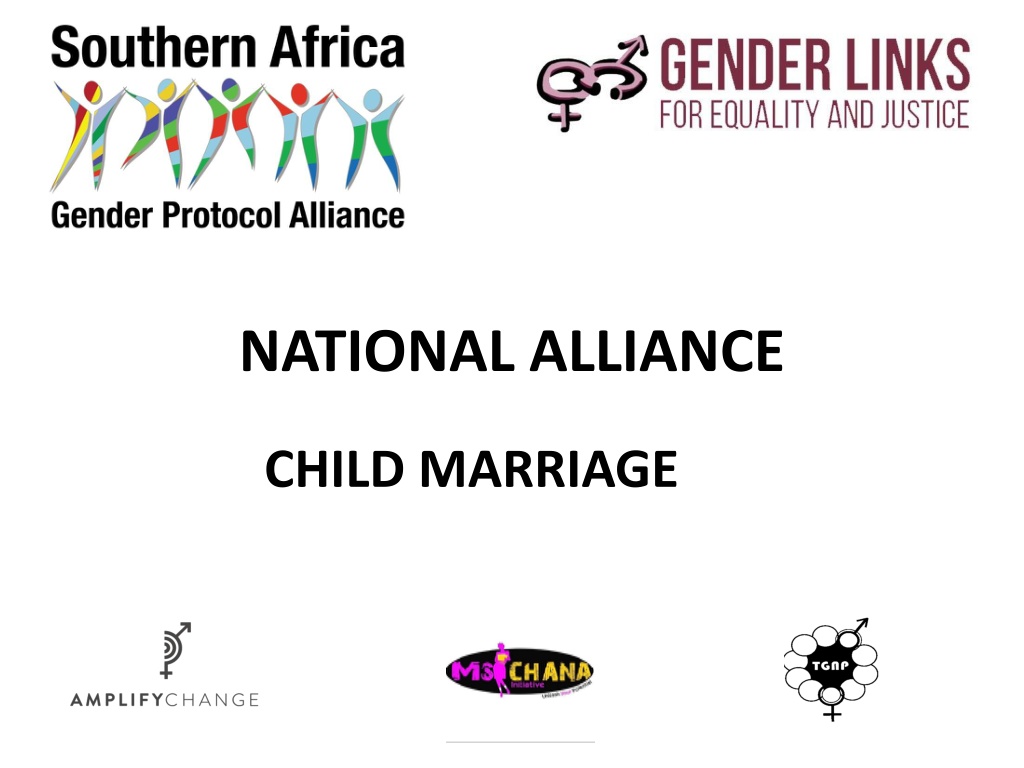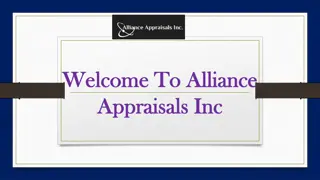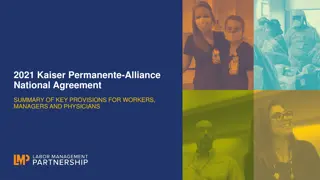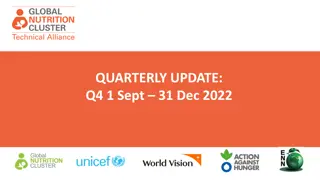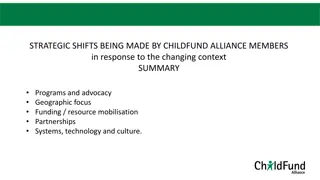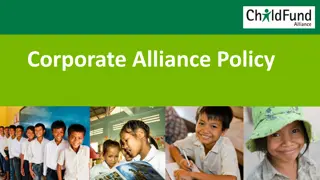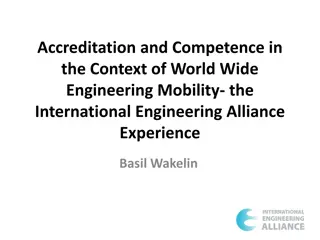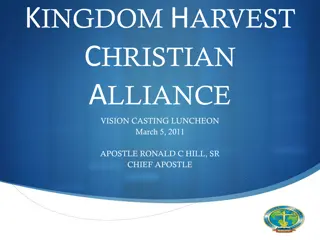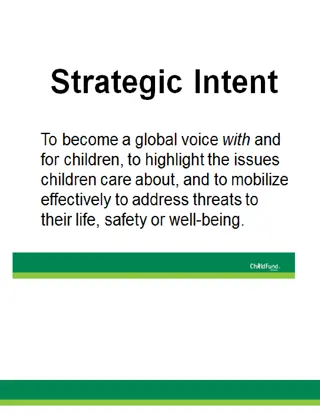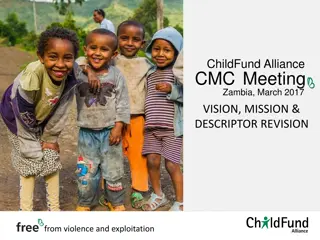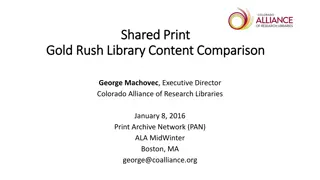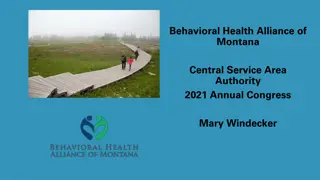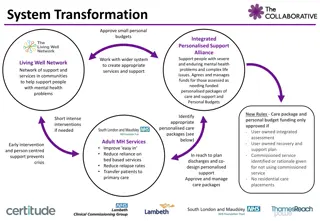NATIONAL ALLIANCE
Child marriage is a violation of human rights with detrimental effects on girls. This content delves into the background, situation analysis, legal frameworks, key actors, targets, objectives, and action plans to combat this issue. It highlights the prevalence of child marriage in Tanzania and explores the drivers behind this harmful practice. The normative frameworks and international commitments to eliminate child marriage are also discussed, emphasizing the importance of creating a socio-economic environment that prevents child marriages.
Download Presentation

Please find below an Image/Link to download the presentation.
The content on the website is provided AS IS for your information and personal use only. It may not be sold, licensed, or shared on other websites without obtaining consent from the author. Download presentation by click this link. If you encounter any issues during the download, it is possible that the publisher has removed the file from their server.
E N D
Presentation Transcript
NATIONAL ALLIANCE CHILD MARRIAGE
What this will cover Background of CM Situation analysis Legal Framework SWOT Key actors Key targets Objectives Messages Action plan short term Action plan long term
BACKGROUND Child marriage is defined as any formal or informal marriage carried out in which either one or both parties under the union is below the age of 18 years. But under most practice child marriage tend to affect more a girl child since the girl under minimum age is automatically not physically, physiologically, and psychologically ready to shoulder the responsibilities of marriage and childbearing. Child marriage is a form of violence and abuse of children s rights set out in numerous international and regional human rights instruments. The Agenda 2030 makes an explicit, bold and universal commitment to ending violence against women and children in all its forms.
SITUATION ANALYSIS Child marriage has increase on number of years, Africa has highest rate with about 4 in 10 girls being married or in a union before the age of 18. Of these girls, as many as 1 in 6 marry before the age of 15 . Child marriage is a human s rights violation and a manifestation of unequal gender relations. Tanzania has 779,000 child brides, placing it 11th highest in the world according to UNICEF. 31% of girls are married before they turn 18 and 5% percent before the age of 15 . According to a current study, child marriage is highest in the regions of Shinyanga (59%), Tabora (58%), Mara (55%) and Dodoma (51%) . Rates are lowest in Iringa (8%) and Dar es Salaam (17%).
CONT There are two distinct sets of drivers for child marriage in Tanzania. The first set relate to norms and practices that include cultural and community attitudes as well as norms relating to marriage, agency and choice. The second are structural drivers and include income poverty and economic dependency; adolescent fertility; access to sexual and reproductive health service, schooling and educational opportunities; Geographical variations and legal frameworks .
Normative frameworks SDGs 5.3: Eliminate all harmful practices, such as child, early, and forced marriage and female genital mutilation. UDHR Article 16(2) marriage shall be entered into only with free and full consent of intending spouses. CEDAWArticle 16(b) The same right freely to choose a spouse and to enter into marriage only with their free and full consent; Article 16 (2) The betrothal and the marriage of a child shall have no legal effect, and all necessary action, including legislation, shall be taken to specify a minimum age for marriage and to make the registration of marriages in an official registry compulsory.
Cont. ICPD 6.11: Countries should create a socio- economic environment elimination of all child marriages and other unions as a matter of urgency and should discourage early marriage. Maputo Protocol Article 6(a) no marriage shall take place without the free and full consent of both parties; Article 6(b) the minimum age of marriage for women shall be 18 years. SADC Protocol Article 8.2a: No person under the age of 18 shall marry. conducive to the
Cont. But also, the Convention on the Rights of the Child (CRC) and the African Convention on the Rights and Welfare of the Child (ACRWC). Which together vests the duty to State Parties to guarantee these human rights by embedding the commitments they have made by setting the minimum age of marriage at 18, register all marriages, and take effective action, including legislation, to eradicate child marriages.
Domestic Laws Under our Domestic Laws, elements of Child Marriage can somehow be traced through Discriminatory, Contradictory, and Vague Laws on the Age of Marriage and Sexual Violence. Law of the Child Act, Cap 13 R.E 2019. Under its interpretation section, the Act defines a child to be anyone who has not yet attained the age of 18 years which directly contradicts with even the Law of Marriage Act that allows such persons to marry. Furthermore, The Child Act does not expressly prohibit child and forced marriage, but prohibits cultural practices that are dehumanizing or are injurious to the physical and mental well-being of a child, which could include child marriage.
Cont. Law of Marriage Act, Cap 29 (1971). Tanzania s Marriage Act of 1971 under section 13 and 17 permits child marriage for girls because It sets the minimum marriage age of marriage for girls at 15 with parental consent, and at 18 for boys. It also permits the marriage of 14-year-old children when a court is satisfied that special circumstances exist, but fails to define what constitutes special circumstances.
Cont. Is there a stand alone Model Law on Child Marriages in Tanzania? When was it adopted? How is it being implemented? Yes there is a model law on Child Marriages in Tanzania. SADC Model Law on Child Marriage. Tanzania participated in the developing of the Law. It has 49 sections including 6key sections. Formally Adopted in June 2016 during 39th assembly of SADC-PF It is implemented through the 5 years NPA-VAWC (2017- 2022) It reflects regionals obligation to implement the provisions of the bill.
Cont. Are advocacy groups aware of the SADC PF Model Law on Child Marriages? Most of the advocacy groups are not aware of the drafted bill although their initiatives targets implementation of the principles of the SADC Model Bill. Has it been domesticated? Not yet because the provisions of the model law clearly requires member states to domesticate its content into national laws. - clearly set the minimum age of marriage to 18 years. Still on process.
Current situation There are number of efforts made by stakeholders to end child marriages in Tanzania but also lobby for amendment of the Law. TECMN strategic plan (2022-2024). Consultation meetings with relevant government actors and ministries. Advocacy with community, religious and leaders, Influential leaders. Media campaigns. Advocacy with parliamentary committees. Community sensitization through media platforms, and community dialogues. Work in collaboration with the government through WCPC to implement NPA-VAWC.
Cont. There is little progress in amending the Law of Marriage Act in Tanzania. (why is there a delay?) COVID-19 eruption. Parliamentary sessions for implementation could not take effect. Government s initiative Ministry to collect community views regarding amendment of LMA,1971. Child rights activists in Tanzania worry that continued delays in closing the legal loophole leaves room for discrimination and marginalization of girls and women. through responsible
STRENGTHS WEAKNESSES THREATS OPPORTUNITIES Alliance building among child rights activist. Government delays although court nullified the sections Prolonged government process of collecting views. Engaged champions in the parliament. SWOT TECMN Strategy (2022- 2024) Joint efforts with media houses and platforms to conduct extensive media campaign. Awareness among community members on SRHR services and rights. (sexuality education, contraceptives, family planning, choices, body autonomy) Harmful traditional practices and cultural beliefs, norms and customs. Engagement in the whole process of collecting community views. We are knowledgeable on roadmap of the government process to amend the law. Poverty is still a big threat. We are part of national, regional and international campaigns. (Global Campaign # girls not bride), (TECMN) Court has nullified the sections unconstitutional
Key actors (partners) Government (MOCLA and Ministry of Health) duty bearers. Parliament (law makers) Developing partners (UN agencies, Women and Adolescent funding agencies ) Bilateral and Multilateral cooperations( embassies ) NGOs
Key targets/ messages TARGET GROUPS MESSAGES Adolescent girls and young women - Child marriages puts an end to your dreams, it denies you bodily autonomy and can result to diseases an death but also vests you with big burdens and responsibilities. Raise your voices against this GBV Traditional and Religious leaders - As gate keepers and influential leaders you have power to put an end to this GBV. Parents - Child marriage is violation against rights of a child and it is not a solution to poverty. Community at large - It is a threat to her lives and against the laws
Objectives Child Marriage is a Violation of International Laws and the mother law of the country. Allowing Child Marriage is not Affirmative Action. The Age of a Child and Age of Marriage are Inseparable Factors. Principle of best interest of the child. Increased experience of domestic and sexual violence. Maternal mortality. Greater exposure to HIV/AIDS(can not negotiate safe sex). Teen pregnancies. School Drop-outs.
CONCLUSION Protecting children (girls and boys) from child marriage is a moral imperative and a legal obligation of the State. Research shows, child marriage increases the average number of children women bear (total fertility) between 11% and 24% in Tanzania depending on the age of marriage . Thus, in addition to increasing opportunities for girls to exercise and enjoy their fundamental rights and freedoms, ending child marriage in Tanzania could reduce the national fertility rate by 6% and reduce the annual rate of population growth by 0.17% point, a reduction in the annual rate of population growth of about 5.5% from the base value.
Action plan short term ACTION WHO WHEN
Action plan long term ACTION WHO WHEN
THE END Protect a Girl Girl Child at all Cost Protect a Child at all Cost
